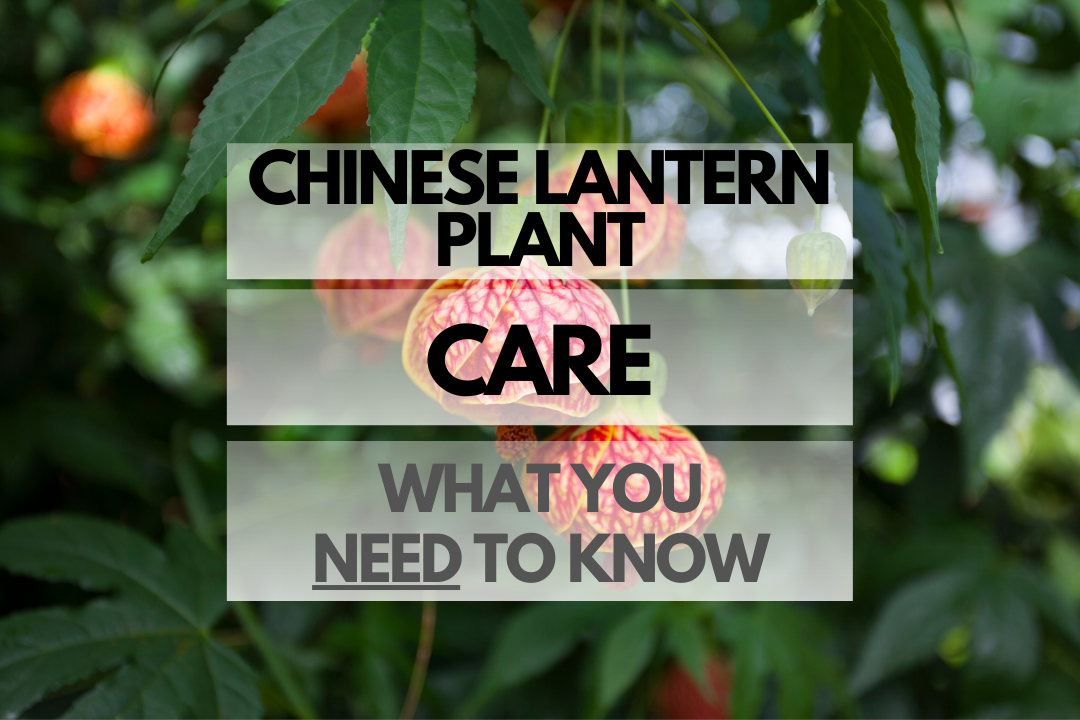Welcome to the fascinating world of Chinese Lantern Plant care! These vibrant and whimsical plants are known for their unique, lantern-like seed pods that add a touch of whimsy to any garden. In this guide, we’ll cover everything you need to know to keep your Chinese Lantern Plant (Physalis alkekengi) happy and healthy.
Chinese Lantern Plant Care Guide
Quick Reference Table: Caring for Chinese Lantern Plant
| Aspect | Requirement |
|---|---|
| Sunlight | Full sun to partial shade |
| Soil | Well-draining, moderately fertile soil |
| Watering | Regular watering, allowing soil to dry slightly between waterings |
| Pruning | Prune in late winter or early spring to control growth and encourage bushiness |
| Temperature | Does not tolerate freezing temperatures; best grown in USDA hardiness zones 3-9 |
| Pots | Containers with drainage holes and well-draining potting mix |
Chinese Lantern Plant Sunlight: Do They Need It and How Much?
Chinese Lantern Plants thrive in full sun to partial shade. They can tolerate a wide range of light conditions, but for optimal growth and vibrant lanterns, aim for a location that receives at least 6 hours of direct sunlight each day. If growing indoors, place the plant near a south or west-facing window for ample light.
Chinese Lantern Plant Soil Tips
These plants prefer well-draining, moderately fertile soil with a pH between 6.0 and 7.0. They can tolerate a variety of soil types, including loam, sand, and clay. When planting in containers, use a high-quality potting mix that provides good drainage to prevent root rot and other moisture-related issues.
Chinese Lantern Plant Watering and Frequency
Water your Chinese Lantern Plant regularly, allowing the soil to dry slightly between waterings. This prevents overwatering and encourages healthy root growth. In hot, dry conditions, you may need to water more frequently to keep the soil consistently moist. If growing in a container, make sure it has drainage holes to prevent waterlogged soil.
Pruning Chinese Lantern Plant Properly
Prune your Chinese Lantern Plant in late winter or early spring to control growth and encourage bushiness. Remove any dead or damaged stems, and trim back any overly long branches. This will promote a more compact, attractive plant and help prevent the spread of disease.
Optimal Chinese Lantern Plant Temperature: Can They Tolerate the Cold?
Chinese Lantern Plants are not frost-tolerant and should be grown in USDA hardiness zones 3-9. In cooler climates, bring container-grown plants indoors before the first frost, or consider growing them as annuals. These plants can survive temperatures down to about 30°F (-1°C) but may suffer damage or die if exposed to freezing temperatures for prolonged periods.
Common Chinese Lantern Plant Problems
Yellowing Leaves
Yellowing leaves can be a sign of overwatering or poor drainage. Ensure your plant is in well-draining soil and avoid letting it sit in standing water. If the problem persists, consider repotting the plant in fresh, well-draining potting mix.
Wilting
Wilting may be a sign of underwatering or root rot. Check the soil moisture and adjust your watering schedule as needed. If the soil is consistently wet, root rot may be the issue. In this case, remove the plant from its container, trim away any damaged roots, and repot in fresh, well-draining soil.
Pests
Chinese Lantern Plants can be susceptible to common pests like aphids, whiteflies, and spider mites. Monitor your plant regularly for signs of infestation and treat with insecticidal soap or neem oil as needed.
Chinese Lantern Plant Outdoors vs Indoors
Chinese Lantern Plants can be grownboth outdoors and indoors, offering versatility for gardeners. Here’s a quick pros and cons list to help you decide which option is best for you:
| Location | Pros | Cons |
|---|---|---|
| Outdoors |
|
|
| Indoors |
|
|
Best Pots for Chinese Lantern Plant
When choosing a container for your Chinese Lantern Plant, opt for one with drainage holes to prevent waterlogged soil. A pot that is slightly larger than the root ball will allow for adequate root growth. Consider using a pot made from a breathable material, such as terra-cotta, to help with moisture control. Pair your pot with a well-draining potting mix to ensure a happy and healthy plant.
Chinese Lantern Plant Facts
Chinese Lantern Plant Benefits
- Aesthetic Appeal: The unique and colorful lantern-like seed pods add visual interest to any garden or indoor space.
- Drought Tolerance: Once established, Chinese Lantern Plants can tolerate dry conditions, making them a low-maintenance option for your garden.
- Medicinal Uses: The plant has been used in traditional Chinese medicine for its anti-inflammatory and diuretic properties.
- Edible Fruit: The small, tomato-like fruits inside the lanterns are edible and can be used in various recipes. However, they should be consumed in moderation as they can be mildly toxic in large quantities.
Growth Rates: How Fast Do They Grow?
Chinese Lantern Plants are relatively fast-growing, with the potential to reach their full height of 24-36 inches (60-90 cm) within one growing season. However, growth rates may vary depending on factors such as light, water, and soil conditions.
Chinese Lantern Plant Lifespan
Chinese Lantern Plants are perennial plants, meaning they can live for several years. In ideal conditions, they can have a lifespan of up to 5-7 years or more. However, in colder climates where they are grown as annuals, they will only live for one growing season.
Are Chinese Lantern Plants Safe?
While the small fruits inside the lanterns are edible, the rest of the Chinese Lantern Plant, including the leaves and flowers, contains toxic compounds and should not be ingested. Ingestion can lead to symptoms such as nausea, vomiting, diarrhea, and abdominal pain. Keep the plant away from children and pets to avoid accidental consumption.
Chinese Lantern Plant Flowers
The flowers of the Chinese Lantern Plant are small, white or pale yellow, and bell-shaped. They bloom from late spring to early summer and are typically hidden beneath the foliage. While the flowers are not as showy as the lanterns, they still add a delicate beauty to the plant.
Chinese Lantern Plant Types and Varieties
Physalis alkekengi
Physalis alkekengi is the most common species of Chinese Lantern Plant. It features bright orange-red lanterns, which can grow up to 2 inches (5 cm) in diameter. The plant can reach a height of 24-36 inches (60-90 cm), with the lanterns appearing in late summer and persisting through the fall.
Physalis alkekengi var. franchetii ‘Gigantea’
This variety of Chinese Lantern Plant, also known as ‘Gigantea,’ has larger lanterns than the standard species, sometimes reaching up to 4 inches (10 cm) in diameter. The plant can grow up to 36-48 inches (90-120 cm) tall and has a more vigorous growth habit.
Chinese Lantern Plant Pros and Cons
| Pros | Cons |
|---|---|
|
|
Chinese Lantern Plant Cost
The cost of a Chinese Lantern Plant can vary depending on factors such as size, variety, and availability. Generally, you can expect to pay anywhere from $5 to $25 for a young plant or a pack of seeds. Larger, more established plants may cost more.
Where to Buy Chinese Lantern Plant
Chinese Lantern Plants can be purchased from local nurseries, garden centers, or online retailers. It’s also possible to find seeds for sale through various online platforms and catalogs. When purchasing a plant, make sure it is labeled as the specific variety you’re interested in and check for signs of good health, such as vibrant foliage andstrong roots.
Is Chinese Lantern Plant Propagation in Water Possible?
Propagating Chinese Lantern Plants in water is not the most common method, but it can be done. To propagate in water, take stem cuttings with at least one node, remove the lower leaves, and place the cutting in a container of water. Make sure to change the water regularly to prevent bacteria growth and provide indirect sunlight. Once the roots have developed, transfer the cutting to a pot with well-draining soil.
Additional Resources
- Missouri Botanical Garden Plant Finder
- National Gardening Association – Physalis Group
- Chinese Lantern Plant Lovers Facebook Group
FAQ for Chinese Lantern Plant Care
Are Chinese Lantern Plants toxic to cats?
Yes, Chinese Lantern Plants are toxic to cats. The plant contains compounds that can cause gastrointestinal distress if ingested. Keep the plant out of reach of your pets.
Are Chinese Lantern Plants toxic to dogs?
Yes, Chinese Lantern Plants are toxic to dogs. Consuming parts of the plant can lead to symptoms such as vomiting, diarrhea, and abdominal pain. Keep the plant away from your pets to avoid accidental ingestion.
Are Chinese Lantern Plants toxic to kids?
Yes, Chinese Lantern Plants can be toxic to children if ingested. While the small fruits inside the lanterns are edible in moderation, the rest of the plant is toxic and can cause symptoms such as nausea, vomiting, and diarrhea. Keep the plant away from children to prevent accidental consumption.
How tall do Chinese Lantern Plants get?
Chinese Lantern Plants can grow to be 24-36 inches (60-90 cm) tall, depending on the specific variety and growing conditions. Some varieties, like ‘Gigantea,’ can reach up to 36-48 inches (90-120 cm) in height.
Can Chinese Lantern Plants live outside?
Yes, Chinese Lantern Plants can be grown outdoors in USDA hardiness zones 3-9. They prefer well-draining soil and a sunny location, but can tolerate partial shade. In colder climates where they are grown as annuals, the plants will not survive the winter outdoors.
Are Chinese Lantern Plants poisonous?
Yes, Chinese Lantern Plants are poisonous, as they contain toxic compounds in their leaves and flowers. Ingesting parts of the plant can cause symptoms such as nausea, vomiting, diarrhea, and abdominal pain. Keep the plant away from children and pets to avoid accidental consumption.
How do I care for my Chinese Lantern Plant?
Chinese Lantern Plants require well-draining soil, a sunny location (though they can tolerate partial shade), and regular watering during the growing season. Prune the plant to control its growth and maintain its shape. Monitor for pests and diseases, and address any issues promptly to keep your plant healthy.

